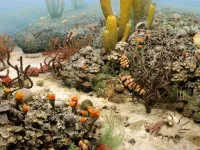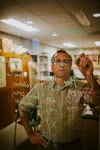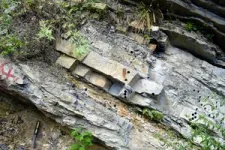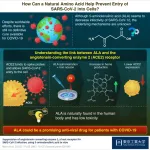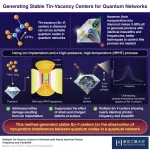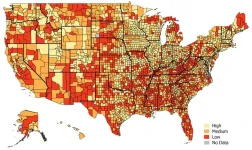(Press-News.org) SAN FRANCISCO, CA (February 24, 2023) — The history of life on Earth has been punctuated by several mass extinctions, the greatest of these being the Permian-Triassic extinction event, also known as the “Great Dying”, which occurred 252 million years ago. While scientists generally agree on its causes, exactly how this mass extinction unfolded—and the ecological collapse that followed—remains a mystery. In a study published today in Current Biology, researchers analyzed marine ecosystems before, during, and after the Great Dying to better understand the series of events that led to ecological destabilization. In doing so, the international study team—composed of researchers from the California Academy of Sciences, the China University of Geosciences (Wuhan), and the University of Bristol—revealed that biodiversity loss may be the harbinger of a more devastating ecological collapse, a concerning finding given that the rate of species loss today outpaces that during the “Great Dying.”
“The Permian-Triassic extinction serves as a model for studying biodiversity loss on our planet today,” says Academy Curator of Geology Peter Roopnarine, PhD. “In this study, we determined that species loss and ecological collapse occurred in two distinct phases, with the latter taking place about 60,000 years after the initial biodiversity crash.”
The event itself wiped out 95% of life on Earth, or about 19 out of every 20 species. Likely triggered by increased volcanic activity and a subsequent spike in atmospheric carbon dioxide, it caused climatic conditions similar to the human-driven environmental challenges seen today, namely global warming, ocean acidification, and marine deoxygenation.
To conduct the study, researchers examined fossils from South China—a shallow sea during the Permian-Triassic transition—to recreate the ancient marine environment. By sorting species into guilds, or groups of species that exploit resources in similar ways, the team was able to analyze prey-predator relationships and determine the functions ancient species performed. These simulated food webs provided plausible representations of the ecosystem before, during, and after the extinction event.
“The fossil sites in China are perfect for this kind of study because we need abundant fossils to reconstruct food webs,” says Professor Michael Benton from the University of Bristol. “The rock sequences can also be dated very precisely, so we can follow a step-by-step timeline to track the extinction process and eventual recovery.”
“Despite the loss of over half of Earth’s species in the first phase of the extinction, ecosystems remained relatively stable,” says Academy researcher Yuangeng Huang, PhD, now at the China University of Geosciences. Interactions between species decreased only slightly in the first phase of the extinction but dropped significantly in the second phase, causing ecosystems to destabilize. “Ecosystems were pushed to a tipping point from which they could not recover,” Huang continues.
An ecosystem as a whole is more resistant to environmental change when there are multiple species that perform similar functions. If one species goes extinct, another can fill that niche and the ecosystem remains intact. This can be compared to an economy where several companies or corporations provide the same service. The demise of one corporation still leaves the service and economy intact, but the opposite will occur if the service is monopolized by a single entity.
“We found that the biodiversity loss in the first phase of the extinction was primarily a loss in this functional redundancy, leaving a sufficient number of species to perform essential functions,” Roopnarine says. “But when environmental disturbances like global warming or ocean acidification occurred later on, ecosystems were missing that reinforced resistance, which led to abrupt ecological collapse.”
For the study team, their findings stress the importance of considering functional redundancy when assessing modern conservation strategies and remind them of the urgent need for action to address today’s human-driven biodiversity crisis.
“We are currently losing species at a faster rate than in any of Earth’s past extinction events. It is probable that we are in the first phase of another, more severe mass extinction,” Huang says. “We cannot predict the tipping point that will send ecosystems into total collapse, but it is an inevitable outcome if we do not reverse biodiversity loss.”
END
New study reveals biodiversity loss drove ecological collapse after the “Great Dying”
By exploring the stability and collapse of marine ecosystems during the Permian-Triassic mass extinction, researchers gain insights into modern biodiversity crisis
2023-02-24
ELSE PRESS RELEASES FROM THIS DATE:
Differences in animal biology can affect cancer drug development
2023-02-24
A small but significant metabolic difference between human and mouse lung tumor cells, has been discovered by Weill Cornell Medicine researchers, explaining a discrepancy in previous study results, and pointing toward new strategies for developing cancer treatments.
The work, published Jan. 30 in Cancer Discovery, focuses on lung adenocarcinoma, a common but often difficult to treat cancer that researchers have long studied in mouse models. However, those models didn’t quite align with human clinical observations in some instances. The new paper shows why; a specific gene mutation has opposite effects on tumor ...
Manchester research captures and separates important toxic air pollutant
2023-02-24
Led by scientists at The University of Manchester, a series of new stable, porous materials that capture and separate benzene have been developed. Benzene is a volatile organic compound (VOC) and is an important feedstock for the production of many fine chemicals, including cyclohexane. But, it also poses a serious health threat to humans when it escapes into the air and is thus regarded as an important air pollutant.
The research published today in journal Chem, demonstrates the high adsorption of benzene at low pressures and concentrations, as well as the efficient separation of benzene and cyclohexane. This was achieved by the design and successful preparation ...
Using the power of artificial intelligence, new open-source tool simplifies animal behavior analysis
2023-02-24
Graphic
A team from the University of Michigan has developed a new software tool to help researchers across the life sciences more efficiently analyze animal behaviors.
The open-source software, LabGym, capitalizes on artificial intelligence to identify, categorize and count defined behaviors across various animal model systems.
Scientists need to measure animal behaviors for a variety of reasons, from understanding all the ways a particular drug may affect an organism to mapping how circuits in the brain communicate to produce a particular behavior.
Researchers ...
WHO and ESCEO announce collaborative agreement to benefit global osteoporosis and fracture prevention
2023-02-24
The World Health Organization (WHO) and the European Society for Clinical and Economic Aspects of Osteoporosis, Osteoarthritis and Musculoskeletal Diseases (ESCEO) signed an agreement to develop a strategic roadmap on bone health and ageing and advocate for a public health strategy to prevent fractures among older people. The collaboration entails a strategic roadmap of research and publication deliverables, in recognition of the fact that osteoporosis is a major contributor to the Global Burden of Disease.
The collaboration agreement, signed on February 23, 2023, at WHO Headquarters in Geneva, Switzerland, is an important ...
Discovery suggests new way to prevent common causes of vision loss
2023-02-24
UVA Health scientists have discovered an unknown contributor to harmful blood vessel growth in the eye that could lead to new treatments for blinding macular degeneration and other common causes of vision loss.
UVA’s Jayakrishna Ambati, MD, and Shao-bin Wang, PhD, and their colleagues have identified a new target to prevent the formation of abnormal tangles of blood vessels associated with eye conditions such as neovascular age-related macular degeneration, proliferative diabetic retinopathy and ischemic retinal vein occlusion.
“Our study has opened up the possibility of mitigating ...
Could a naturally occurring amino acid lead us to a cure for COVID-19?
2023-02-24
After more than two years since its discovery, six million deaths, and half a billion reported cases, there is still no effective cure for COVID-19. Even though vaccines have lowered the impact of outbreaks, patients that contract the disease can only receive supportive care while they wait for their own body to clear the infection.
A promising COVID-19 treatment strategy that has been gaining traction lately is targeting angiotensin-converting enzyme 2 (ACE2). This is a receptor found on the cell membrane that allows entry of the virus into the cell due to its ...
Breakthrough in tin-vacancy centers for quantum network applications
2023-02-24
Quantum entanglement refers to a phenomenon in quantum mechanics in which two or more particles become linked such that the state of each particle cannot be described independently of the others, even when they are separated by a large distance. The principle, referred to by Albert Einstein as "spooky action at a distance", is now utilized in quantum networks to transfer information. The building blocks of these networks—quantum nodes—can generate and measure quantum states.
Among the candidates that can function as ...
Low income, race, and rural residence among risk factors for low telemedicine literacy
2023-02-24
February 24, 2023 – Demographic factors including low income and living in a rural area are linked to low telemedicine literacy – which may limit access to plastic surgeons and other healthcare providers at a time of expanding use of telehealth and video visits, according to a report in the March issue of Plastic and Reconstructive Surgery®, the official medical journal of the American Society of Plastic Surgeons (ASPS). The journal is published in the Lippincott portfolio by Wolters Kluwer.
"Our ...
Risk of cancer remains high for women over 50 with genetic BRCA1 or BRCA2 mutation
2023-02-24
Although genetic mutations in BRCA1 or BRCA2 are associated with a younger onset of breast and ovarian cancer, women with these genetic mutations continue to face a high risk of cancer incidence after age 50, even if they have not been previously diagnosed with cancer. This is according to a new study led by Kelly Metcalfe, a professor at the Lawrence S. Bloomberg Faculty of Nursing.
The study published recently in the American Cancer Society Journal Cancer, followed over 2000 women between the ages of 50 to 75, from 16 countries, who were aware they had a BRCA mutation ...
Cleft lip and palate surgery procedures are undervalued, study suggests
2023-02-24
February 24, 2023 – Plastic surgery procedures performed to correct cleft lip and palate deformities in infants and children are economically undervalued, relative to pediatric craniofacial procedures, concludes an analysis in the March issue of Plastic and Reconstructive Surgery®, the official medical journal of the American Society of Plastic Surgeons (ASPS). The journal is published in the Lippincott portfolio by Wolters Kluwer.
The study finds unbalanced allocation of relative value units (RVUs) used in billing and compensation for cleft surgery in children, compared to craniofacial procedures, report Roberto L. Flores, MD, of Hansjörg ...
LAST 30 PRESS RELEASES:
For teens, any cannabis use may have impact on emotional health, academic performance
School meals could unlock major gains for human and planetary health
Menopause hormone therapy does not appear to impact dementia risk
Signature patterns of brain activity may help predict recovery from traumatic brain injury
Dresden study uncovers new key mechanism in cancer cells
New species are now being discovered faster than ever before, study suggests
Cannabis-based products show limited short-term benefit for chronic pain, with increased risk of adverse effects
Cannabis products with more THC slightly reduce pain but cause more side effects
Clearing the brain of aging cells could aid epilepsy and reduce seizures
Brain injuries linked with potential risk of suicide, new study finds
New technique lights up where drugs go in the body, cell by cell
New study finds movement of fishing fleets can reveal shifts in marine ecosystems
Embargoed: New evidence points to potential treatment for vascular dementia
Study uncovers disrupted brain balance in alcohol dependence
Working in groups can help Republicans and Democrats agree on controversial content moderation online
Structural findings reveal how distinct GPCR ligands create different levels of activation
Anything-goes “anyons” may be at the root of surprising quantum experiments
UC review: Maximizing workplace opportunity for veterans
From generation to complex control: Metasurfaces make perfect vortex beams "within reach"
Thin-film lithium niobate-based detector: recent advances and perspectives
Exploring why some people may tend to persistently make bad choices
How cells balance their protein levels
Nirsevimab vs RSVpreF vaccine for RSV–related hospitalization in newborns
Effectiveness and impact of maternal RSV immunization and nirsevimab on medically attended RSV in US children
AI gives scientists a boost, but at the cost of too many mediocre papers
Next-generation vision model maps tree growth at sub-meter precision
Genes aren’t destiny for inherited blindness, study shows
MIT study: High-fat diets make liver cells more likely to become cancerous
Exposure to multiple fine particulate matter components and incident depression in the US Medicare population
Risk of burdensome health care spending over time in the US
[Press-News.org] New study reveals biodiversity loss drove ecological collapse after the “Great Dying”By exploring the stability and collapse of marine ecosystems during the Permian-Triassic mass extinction, researchers gain insights into modern biodiversity crisis
